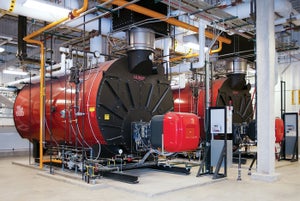Boiler and chiller makers address hospital needs
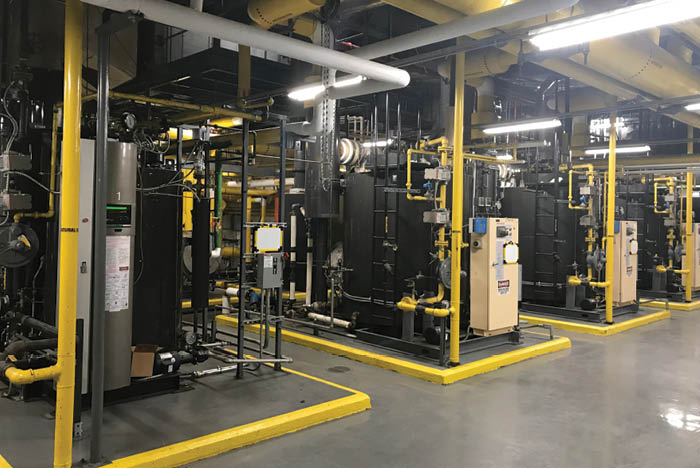
Image courtesy of Miura America Co.
Boiler and chiller manufacturers have been busy upgrading their equipment in their quest to provide essential heating and cooling for demanding health care environments.
While boiler makers have been focusing on technology to improve reliability, reduce emissions, and expand size and power choices, chiller manufacturers have concentrated on improving efficiency, reducing maintenance and upgrading sustainability.
Boiler challenges
Challenges to boiler manufacturers abound. Hospitals operate continually, so they have no planned downtime. Boiler operations must be able to support ongoing hospital operations as well. Redundancy, reliability and the ability to back up systems at appropriate times are critical. Hospitals also need boiler systems that are capable of operating on two or more fuel sources.
The good news is that new technology is improving boiler control and reducing the levels of atmospheric pollutants emitted. Advances in remote monitoring and sensors are improving boiler room control by keeping operators and other team members aware of system updates from various locations. This visualization into the components of boiler systems via advanced monitoring minimizes the impact of unforeseen issues.
During the past 10 to 15 years, significant research and development has been devoted to reducing nitrogen oxide (NOx) emissions. These reductions have resulted in a combination of boiler and burner redesigns and advanced controls that maintain boilers at peak efficiency as loads and atmospheric conditions change, according to Gregg Achtenhagen, PE, LEED AP BD+C, senior manager at Cleaver-Brooks, Thomasville, Ga. “Modern firetube boilers and condensing boilers can achieve sub-9 parts per million (ppm) NOx as opposed to 60-plus ppm just a few years ago. In addition, as boilers become more efficient, they emit less carbon dioxide overall, due to burning less fossil fuel.”
Many hospitals are moving toward hot-water systems, according to Doug Wright, president and CEO of Superior Boiler, Hutchinson, Kan. Reflecting that trend, his company recently introduced the Cheyenne firetube hot water-condensing boiler, which is targeted at the health care market and meets the dual-fuel requirement associated with hospital boiler systems. “The Cheyenne is a high-efficiency, UL-certified package that emphasizes the larger system requirements found in 4 metric million British thermal units per hour (mmbtuh) to 12 mmbtuh boiler systems.”
Weil-McLain, Burr Ridge, Ill., offers the 1,500- to 3,000-MBH Stainless Vertical Firetube boiler line, which features a stainless steel, vertical firetube and shell heat exchanger for corrosion resistance and thermal efficiency up to 96.8%, according to David DeVries, director of product management. “User-friendly controls make installation and operation easy, and a serviceable and replaceable condensate tray offers long-term corrosion resistance. The boilers use less fuel and offer a green solution, and that efficiency contributes to lower operating costs, which can result in LEED points and effective green building certifications.”
Cleaver-Brooks offers the ClearFire-CE condensing boiler, a compact, high-mass firetube design that achieves up to 99% efficiency through its heat exchanger featuring AluFer technology, according to Achtenhagen. “Due to its highly effective heating surface area and true counter-flow heat exchanger arrangement, the CFC-E performs at maximum efficiency in all operating conditions. Also, its self-regulating, fuel-air ratio control and electronically commutated motor, and variable-speed combustion air blower help keep emissions, noise levels and energy use to a minimum.”
To give users greater monitoring power and flexibility, Miura America Co., Rockmart, Ga., has introduced the Miura Connect web-based remote monitoring portal. It provides a real-time, remote view of all connected equipment in the boiler room, including water treatment. Team members can view system health, export trending data, and receive alerts to their smart devices via text messaging or email. “This is beneficial to hospital facilities managers because it ensures continuous steam production with flexibility to monitor the boiler room from anywhere and at any time,” says Andrew Eklind, marketing manager. “It also makes integration with the hospital’s building automation system easy.”
Aerco, a Watts Brand, Blauvelt, N.Y., offers the Benchmark Platinum 750/1,000-MBH Dual Fuel boiler, which is suitable for small health care facilities such as urgent care centers. Measuring 28 inches wide by 34 inches deep, it is the most compact dual-fuel boiler in its size range, according to Christian Zapata, product manager for hydronic solutions.
“Our boiler sequencing technology and Aertrim oxygen (O2) trim technology allow the boiler to operate at its most efficient firing rate at optimum O2 levels, resulting in lower operating and maintenance costs, greater uptime reliability and lower emissions,” Zapata says.
Among non-boiler products, Lync by Watts, Fort Worth, Tex., has introduced the Lync Element, an all-in-one hot water solution that offers high-efficiency water heating, multi-barrier pathogen mitigation and water quality treatment. It features 600- to 1,000-MBH output and up to 30 gallons per minute of treated flow.
Looking ahead, Zapata says that electrification is gaining traction in all industry sectors, and he expects hospital boilers to follow suit. “Boiler solutions are evolving but the momentum of moving to full electrification depends mainly on local jurisdiction requirements and electric grid resiliency,” Zapata says.
Wright predicts that the trend toward lower emissions will continue to migrate across the country and that market forces will continue to drive greater boiler efficiencies. “We will start to see different and more exotic types of fuels — such as renewable biofuels and hydrogen — used for fire boilers. The market will continue to evolve, and there’s no doubt hospital systems will play a key role in that evolution.”
Chiller priorities
When designing a chiller system for a health care facility, it’s critical to provide the most efficient system that offers uninterrupted service, according to James Barr, director of chiller service support at Johnson Controls, Milwaukee. “Backup chillers and N+1 redundancy should be top of mind to ensure 24/7 comfort,” he says.
The decision of whether to use one large chiller or multiple smaller units when designing an HVAC system is another variable. “For example, a building that requires a 1,500-ton load could be designed with three smaller centrifugal chillers at 500 tons; this would provide N+1 redundancy or N=2+ versus one chiller with no redundancy,” Barr says.
Hospitals are now required to have heat recovery chillers per ANSI/ASHRAE/IES Standard 90.1-2019, Energy Standard for Buildings Except Low-Rise Residential Buildings, according to Scott DeGier, vice president of sales for Multistack LLC, Sparta, Wis. “While some hospitals have already included heat recovery chillers in their central plant to improve building efficiency by reusing the heat they already own and thus reducing their carbon footprint, many hospitals have not, due to the added complexity to their building operation and controls.”
Hospitals are large consumers of simultaneous heating and cooling, so more heat recovery chillers are being used within them, according to Daniel Gentry, HVAC systems application engineer for Trane Commercial HVAC Americas, Davidson, N.C. Trane recently introduced several air- and water-cooled chillers and heat pumps that are well suited for the hospital environment.
Trane’s Agility chiller is one example. “It is a magnetic-bearing centrifugal chiller capable of being used for heat recovery,” Gentry says. “The Agility compressor can achieve more lift and warmer water temperatures leaving the condenser as compared to other available technology. This means that it can provide more opportunities with its expanded operating capabilities. The Agility also is compact, so it can fit in a limited space.” Gentry adds that electrification of buildings is a growing trend. Reflecting that trend, Trane recently released a new air-to-water heat pump that can help hospitals achieve electrification.
Carrier develops water-cooled chiller technologies aimed at protecting a building’s assets while reducing operating costs. The company’s EquiDrive two-stage, back-to-back economized centrifugal compressor technology — first introduced in 2017 with the AquaEdge 19DV and then with the AquaEdge 19MV in 2021 — delivers reliable, flexible and efficient operation well suited for health care applications, according to Tom Franaszek, director of global product management for water-cooled chillers at Carrier Commercial HVAC in Charlotte, N.C.
“This includes stable operation when condenser water temperatures rise above design conditions caused by a heat wave, [an] unplanned maintenance event or pump issues, while maintaining best-in-class efficiency at design conditions,” Franaszek says. “When condenser water temperatures are cold, the EquiDrive compressor technology works seamlessly with a building’s waterside economizer system to optimize free cooling operation.”
Johnson Controls continues to make technological advances that increase the efficiency of its York water-cooled and air-cooled chillers, and the greatest opportunity for improving efficiency exists in optimizing the operation of the system, according to Barr.
“Johnson Controls’ central utility plant optimization software is the latest efficiency enhancement for chiller operation as part of our OpenBlue digital platform,” Barr says. “We are using data to drive intelligent, automated decision-making in order to drive down operating costs. This data also is used to increase reliability through predictive analysis as slight changes provide an early indication of potential problems.”
Danfoss Turbocor, Tallahassee, Fla., a manufacturer of oil-free compressor technology for HVAC systems, has expanded its line with the TGS490, an oil-free, variable-speed, magnetic-bearing centrifugal compressor qualified for the use of R515B. R515B has an AR5 GWP of 299 and an ASHRAE A1 safety classification for lower toxicity and no flame propagation.
“The Danfoss Turbocor TGS490 compressor answers a market need for high-efficiency chillers in areas that do not permit the use of A2L refrigerants — enabling compliance with both refrigerant regulations and safety codes,” says Ricardo Schneider, president and CEO. Danfoss Turbocor oil-free compressors offer fast restart, which enables them to restart as soon as 30 seconds upon power restoration, Schneider adds. This minimizes catastrophic downtime of cooling for critical facilities such as hospitals.
Multistack LLC offers the DHRC (Dedicated Heat Recovery Chiller) family of chillers. Recent upgrades include the True-Variable Speed Scroll DHRC module and the MagLev DHRC. “The MagLev DHRC delivers centrifugal chiller performance in both a modular and packaged format and can provide systems that produce 60 to several thousand tons of simultaneous heating and cooling capacity,” DeGier says.
“The DHRC MagLev chillers continue our tradition of seamless integration of heat recovery into hospital systems by embedding the complicated controls required for heat recovery operation within the chiller controls,” DeGier adds. “This simplified approach gives a hospital a system that can significantly reduce its carbon footprint and operating costs without compromising comfort.”
Chillers acting as heat pumps to provide hot water represent a growing trend, according to Brian Dail, segment marketing manager for A/C Solutions at Danfoss North America, Baltimore. “This trend will allow chillers to decarbonize HVAC systems by replacing, or at least supplementing, fossil fuel-burning boilers with heat pumps,” says Dail. “Greater connectivity also will improve maintenance and spot ways for system settings to be changed and improve efficiency.”
Decarbonization goals
As sustainability and decarbonization are on the forefront of health care organizations’ goals, the industry will see more use of heat reclaim chillers combined with condensing boilers to handle most of a hospital’s heating requirements, Gentry predicts. “High-grade heating loads such as sterilization and humidification will remain with natural gas-fired steam boilers.”

DOUBLE DUTY
Benchmark Platinum 750/1,000-MBH dual-fuel boilers are suitable for small health care facilities such as urgent care centers. Aerco, a Watts Brand
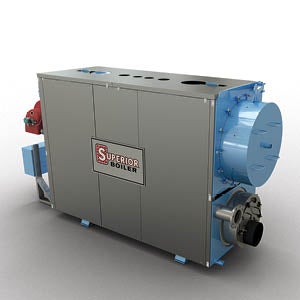
KEEPING IT HOT
The Cheyenne is a high-efficiency hot water condensing boiler featuring dual-fuel capability to support hospital boiler room operations. Superior Boiler
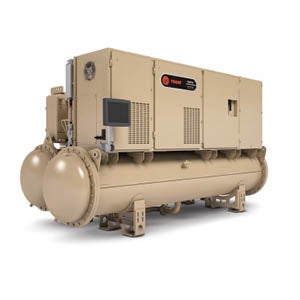
BALANCED APPROACH
The Agility chiller delivers a balance of size and efficiency while keeping installation costs low. Trane
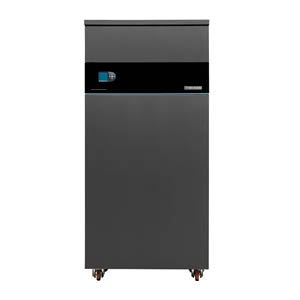
COST CONTROL
SVF boiler features thermal efficiency up to 96.8%, which contributes to less fuel usage and lower operating costs. Weil-McLain

UPGRADED EFFICIENCY
Miura’s dual-fuel, modular EX-Series steam boiler system is designed to improve efficiency in hospitals. Miura America Co.
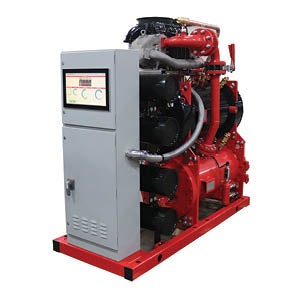
ENERGY WISE
The MSH_M – Modular MagLev DHRC chiller delivers simultaneous heating and cooling, thus reducing a hospital’s energy consumption and carbon emissions. Multistack LLC
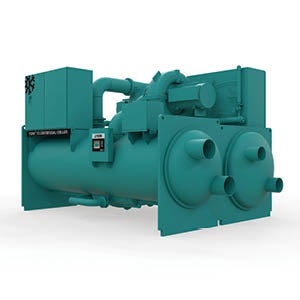
THINKING GLOBALLY
The YORK YZ magnetic bearing centrifugal chiller is optimized around R-1233zd(E), a next-generation low-global warming potential refrigerant, to provide the highest possible efficiency. Johnson Controls

READY TO RUN
The TGS490 compressor features oil-free technology and fast restart, enabling it to operate efficiently and minimize catastrophic downtime. Danfoss Turbocor

EFFICIENT OPERATION
The ClearFire-CE condensing boiler has a compact, high-mass firetube design that achieves up to 99% efficiency. Cleaver-Brooks
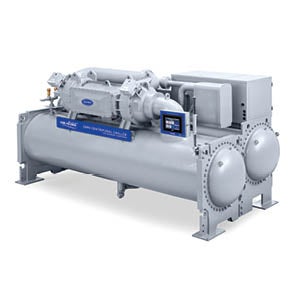
BUILDINGWIDE MISSION
The compact and versatile Carrier AquaEdge centrifugal chiller targets whole-building energy efficiency. Carrier
Neal Lorenzi is a Mundelein, Ill.-based contributor to Health Facilities Management.




